Article originally published on seekingalpha.com
About the author: Harrison Schwartz
Event-driven, research analyst, newsletter provider, ETF investing
Summary
While the rest of the world's equities struggle, Egypt's are marching higher.
Successful economic reforms and high interest rates have caused the Egyptian pound to become very strong.
Most companies in VanEck's EGPT ETF trade at "P/E" valuations below 10X and have strong revenue growth.
The country's long-run potential is great, and its economy makes a full recovery following a return to political and economic stability.
Looking for a portfolio of ideas like this one? Members of The Country Club get exclusive access to our model portfolio.
As equities and bonds look less attractive by the day, investors must look for new places to invest their money that have low systemic risk. Not low risk (i.e. volatility), but simply low correlations to other major assets. Indeed, according to Ray Dalio, the "Holy Grail of Investing" is finding assets with near-zero correlation to each other that are expected to deliver positive returns.
To do so, we must venture our portfolios into new and exciting territories. Specifically, frontier markets. One frontier market economy that is looking very attractive is Egypt. One can easily invest in the country's largest companies through the VanEck Vectors Egypt Index ETF (NYSEARCA:EGPT). Of course, Egypt is "scary" to many investors because of its recent(ish) political turmoil and 2016 currency devaluation. This excessive fear is exactly what makes it such a land of discounts.
While risks are still high in Egypt, they have been on the steady decline, and the Egyptian pound has actually been appreciating to the U.S. dollar. As other equity markets struggle to maintain the investment, financial inflows into Egyptian stocks are finally rising. While the country may struggle with its debt burden, it is one of the fastest-growing countries in the world, and recovery to its past economic health is likely. Even more, most of its equities trade at "P/E" valuations below 10X.
Introduction to The VanEck Egypt ETF
EGPT is actually not a particularly new ETF and has been trading since 2010. It has seen many ups and downs along the way as the country's political system has had many ups and downs (to say the least). The fund has 27 holdings that are diversified across the Egyptian economy with no particular sector being well over a quarter of the fund. Take a look at its sector breakdown and currency exposure below:
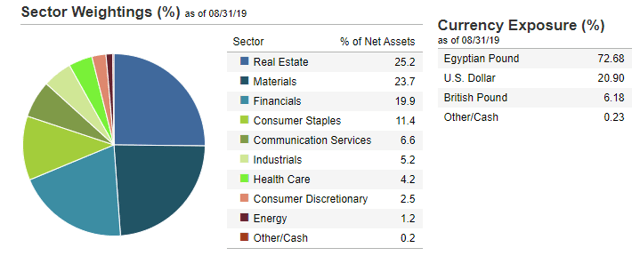
This is a great sign. Although financials and materials tend to be riskier, those sectors globally have the largest discount and I expect materials to perform quite well as inflation fundamentals continue to rise in developing nations.
Most of the fund's holdings are very small and have an average weighted market cap of merely $1.6B which is another positive because they likely have greater growth potential and less systemic risk. Speaking of which, the fund has a correlation to the S&P 500 of 0.11. This is incredibly low and is a sign that the ETF has no statistically significant global equity exposure. This low exposure is the cornerstone of my investment thesis on the country.
Have investors begun to take note? Perhaps they are just beginning to allocate back into the fund. Take a look at the ETF's total return price (which includes dividends) vs. its AUM since it was launched:
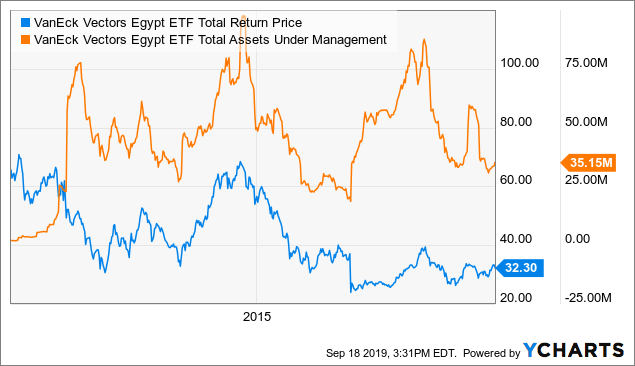
As you can see, fund flows into the ETF tend to be very cyclical. When total AUM is around $30M, inflows usually have increased along with Egyptian equity prices. Today, AUM is at a low while EGPT is trending higher; this may be a sign that a wave of strong performance could occur.
For assessing long-run performance, let's take a look at the fund's holding fundamentals and the Egyptian economy in general.
Economic Growth Engine Restarting?
Unfortunately, many of the detailed fundamentals I like to discuss with single-country ETFs are not readily available for Egyptian companies so we will need to look at it from a big-picture perspective.
To begin, the fund is relatively cheap with a current weighted average "P/E" ratio of 9.7X. This is what I deem "fair value" for a riskier frontier market fund like Egypt, but it is undervalued when growth rates and currency effects are taken into account.
The fund also has a weighted average "P/B" of 1.35X, which signals that many of the stocks are trading at less than book value considering the fact that a little less than half of the companies are in high "P/B" industries.
The largest holding in the ETF is the Commercial International Bank of Egypt which is available as an OTC in the U.S under the ticker OTCQX:CIBEY. Thus, we can use the company as a case study of revenue flows. Although it makes up only 10% of the fund, it is a private-sector bank in Cairo, so it is likely quite representative of most Egyptian stocks in EGPT.
Take a look at the company's valuation, revenue, and price over time:
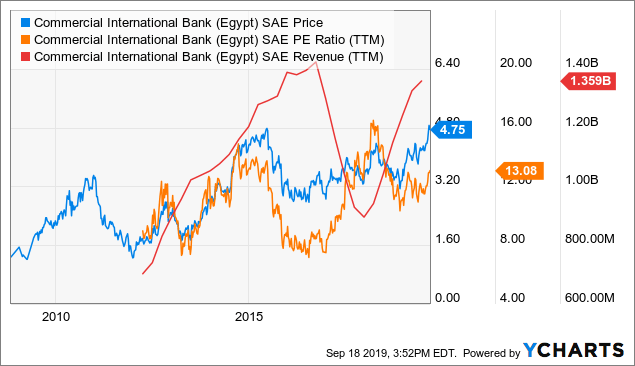
ChartData by YCharts
As you can see, this bank has been steadily growing. Its revenue took a significant hit during the 2017-2018 time frame while the Egyptian economy saw a growth slowdown and inflation spiked. Revenues have recovered since and appear to be growing at a very fast rate and are likely to make new highs (barring another shock).
Speaking of which, let's jump over to the country's macro landscape. Because most of the companies generate the bulk of their revenue in Egypt, the country's economic health will be the primary determinant of long-run investment returns for EGPT.
Following the currency devaluation in 2016 that led to an economic slowdown and inflationary spike in 2017, the Central Bank of Egypt raised rates to over 18% which has pushed inflation very low:
Note, inflation at the left axis (currently 4.9%)
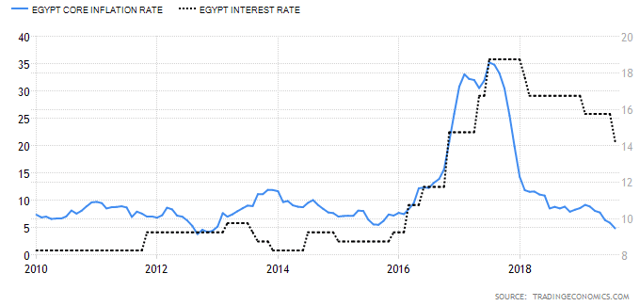
(Source - Trading Economics)
As you can see, the country was very successful in its effort to fight inflation and today the real interest rate (interest rate minus inflation) in Egypt is 10%. Real interest rates in the developed world are negative across the board, making the Egyptian pound (which EGPT returns are dependent upon) a very attractive investment.
While the rest of the world's currencies are depreciating against the U.S. dollar and hurting international investors, the Egyptian pound is appreciating. Take a look at EGPT vs. the currency below:
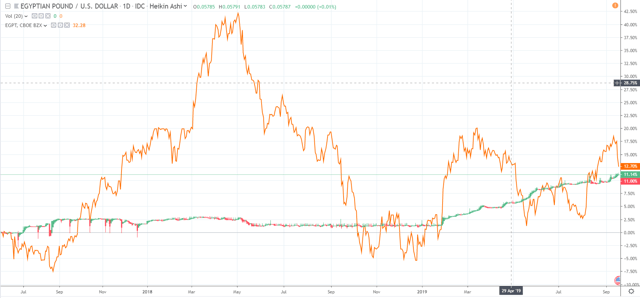
(Source - Trading View)
This is a great sign because it signals that economic confidence in the country is on the rise and that its leaders are finally making an attractive investment landscape. While the country is still running a wide budget deficit, its GDP is growing quickly and the deficit is shrinking by the year. Take a look at the Egyptian budget to GDP over the years:
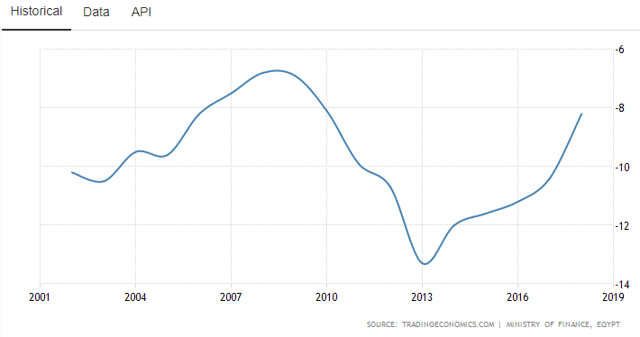
(Source - Trading Economics)
If this trend continues (as I expect), then the currency will likely continue to appreciate which will boost EGPT. Even more, it will help boost banks' balance sheets and income (as well as the very high-interest rates).
The Bottom Line
While financial risks exist in the country, they are lower than many believe. Egyptian credit ratings have been on the rise due to the current president's successful economic reforms. You never know for certain with frontier countries, but it does seem that Egypt is headed for a long period of strong and stable economic growth.
Take a look at the country's GDP growth over the past few decades:
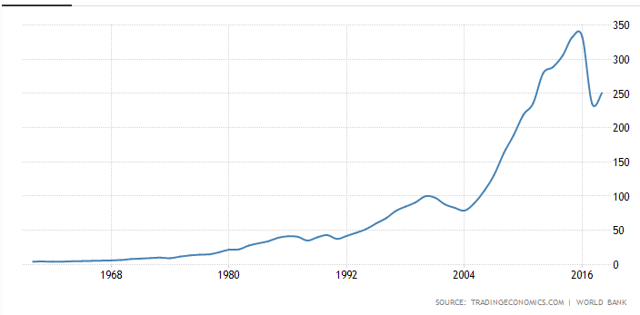
(Source - Trading Economics)
As you can see, growth has been very strong. The 2010-2016 period of turmoil put a serious damper on the country's GDP, but this means the country has easy upside potential as it plays catch-up.
Equities and the pound are rising while the world GDP is slowing, Egypt is likely to slow a bit if its neighbors do as well. Recent events in Saudi Arabia may be negative for the country from a trade perspective. That said, the country may see very high inflows due to Saudi/Middle Eastern money flowing out of the banking sector. Put simply, I believe EGPT is a "buy" for long-term investors.
Interested In Closely Following Global Events?
"The Country Club" is a dedicated service that focuses on single-country and regional ETFs with the goal of helping our subscribers diversify globally and get a better grasp on how world events will affect their portfolio. We will certainly be providing subscribers further updates on this idea.
Subscribers receive exclusive ideas, model portfolios, and a wide range of tools including our exclusive "Country Club Dashboard" which allows them to visualize global financial and economic data. If you haven't already, please consider our 2-week free trial and get your passport to global markets today!
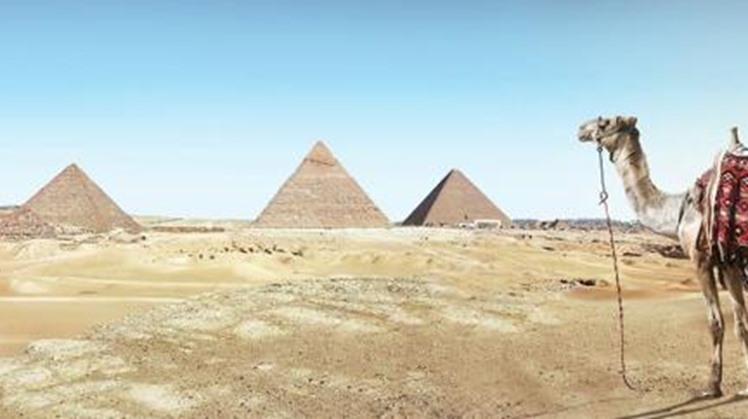 Mon, Sep. 23, 2019
Mon, Sep. 23, 2019






